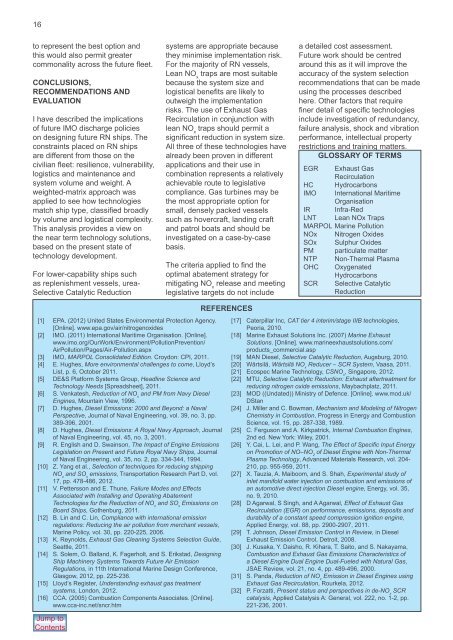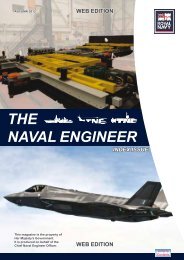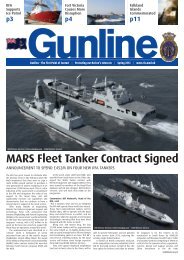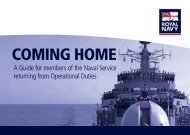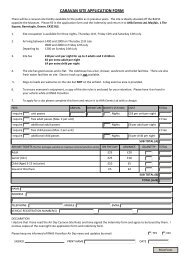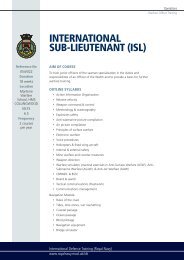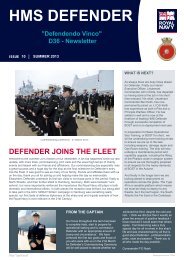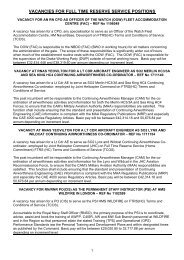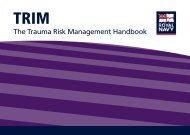THE NAVAL ENGINEER
THE NAVAL ENGINEER
THE NAVAL ENGINEER
Create successful ePaper yourself
Turn your PDF publications into a flip-book with our unique Google optimized e-Paper software.
16<br />
to represent the best option and<br />
this would also permit greater<br />
commonality across the future fleet.<br />
Conclusions,<br />
Recommendations and<br />
Evaluation<br />
I have described the implications<br />
of future IMO discharge policies<br />
on designing future RN ships. The<br />
constraints placed on RN ships<br />
are different from those on the<br />
civilian fleet: resilience, vulnerability,<br />
logistics and maintenance and<br />
system volume and weight. A<br />
weighted-matrix approach was<br />
applied to see how technologies<br />
match ship type, classified broadly<br />
by volume and logistical complexity.<br />
This analysis provides a view on<br />
the near term technology solutions,<br />
based on the present state of<br />
technology development.<br />
For lower-capability ships such<br />
as replenishment vessels, urea-<br />
Selective Catalytic Reduction<br />
systems are appropriate because<br />
they minimise implementation risk.<br />
For the majority of RN vessels,<br />
Lean NO x<br />
traps are most suitable<br />
because the system size and<br />
logistical benefits are likely to<br />
outweigh the implementation<br />
risks. The use of Exhaust Gas<br />
Recirculation in conjunction with<br />
lean NO x<br />
traps should permit a<br />
significant reduction in system size.<br />
All three of these technologies have<br />
already been proven in different<br />
applications and their use in<br />
combination represents a relatively<br />
achievable route to legislative<br />
compliance. Gas turbines may be<br />
the most appropriate option for<br />
small, densely packed vessels<br />
such as hovercraft, landing craft<br />
and patrol boats and should be<br />
investigated on a case-by-case<br />
basis.<br />
The criteria applied to find the<br />
optimal abatement strategy for<br />
mitigating NO x<br />
release and meeting<br />
legislative targets do not include<br />
a detailed cost assessment.<br />
Future work should be centred<br />
around this as it will improve the<br />
accuracy of the system selection<br />
recommendations that can be made<br />
using the processes described<br />
here. Other factors that require<br />
finer detail of specific technologies<br />
include investigation of redundancy,<br />
failure analysis, shock and vibration<br />
performance, intellectual property<br />
restrictions and training matters.<br />
Glossary of Terms<br />
EGR Exhaust Gas<br />
Recirculation<br />
HC Hydrocarbons<br />
IMO International Maritime<br />
Organisation<br />
IR Infra-Red<br />
LNT Lean NOx Traps<br />
MARPOL Marine Pollution<br />
NOx Nitrogen Oxides<br />
SOx Sulphur Oxides<br />
PM particulate matter<br />
NTP Non-Thermal Plasma<br />
OHC Oxygenated<br />
Hydrocarbons<br />
SCR Selective Catalytic<br />
Reduction<br />
[1] EPA. (2012) United States Environmental Protection Agency.<br />
[Online]. www.epa.gov/air/nitrogenoxides<br />
[2] IMO. (2011) International Maritime Organisation. [Online].<br />
www.imo.org/OurWork/Environment/PollutionPrevention/<br />
AirPollution/Pages/Air-Pollution.aspx<br />
[3] IMO, MARPOL Consolidated Edition. Croydon: CPI, 2011.<br />
[4] E. Hughes, More environmental challenges to come, Lloyd’s<br />
List, p. 6, October 2011.<br />
[5] DE&S Platform Systems Group, Headline Science and<br />
Technology Needs [Spreadsheet], 2011.<br />
[6] S. Venkatesh, Reduction of NO x<br />
and PM from Navy Diesel<br />
Engines, Mountain View, 1996.<br />
[7] D. Hughes, Diesel Emissions: 2000 and Beyond: a Naval<br />
Perspective, Journal of Naval Engineering, vol. 39, no. 3, pp.<br />
389-396, 2001.<br />
[8] D. Hughes, Diesel Emissions: A Royal Navy Approach, Journal<br />
of Naval Engineering, vol. 45, no. 3, 2001.<br />
[9] R. English and D. Swainson, The Impact of Engine Emissions<br />
Legislation on Present and Future Royal Navy Ships, Journal<br />
of Naval Engineering, vol. 35, no. 2, pp. 334-344, 1994.<br />
[10] Z. Yang et al., Selection of techniques for reducing shipping<br />
NO x<br />
and SO x<br />
emissions, Transportation Research Part D, vol.<br />
17, pp. 478-486, 2012.<br />
[11] V. Pettersson and E. Thune, Failure Modes and Effects<br />
Associated with Installing and Operating Abatement<br />
Technologies for the Reduction of NO x<br />
and SO x<br />
Emissions on<br />
Board Ships, Gothenburg, 2011.<br />
[12] B. Lin and C. Lin, Compliance with international emission<br />
regulations: Reducing the air pollution from merchant vessels,<br />
Marine Policy, vol. 30, pp. 220-225, 2006.<br />
[13] K. Reynolds, Exhaust Gas Cleaning Systems Selection Guide,<br />
Seattle, 2011.<br />
[14] S. Solem, O. Balland, K. Fagerholt, and S. Erikstad, Designing<br />
Ship Machinery Systems Towards Future Air Emission<br />
Regulations, in 11th International Marine Design Conference,<br />
Glasgow, 2012, pp. 225-236.<br />
[15] Lloyd’s Register, Understanding exhaust gas treatment<br />
systems, London, 2012.<br />
[16] CCA. (2005) Combustion Components Associates. [Online].<br />
www.cca-inc.net/sncr.htm<br />
Jump to<br />
Contents<br />
REFERENCES<br />
[17] Caterpillar Inc, CAT tier 4 interim/stage IIIB technologies,<br />
Peoria, 2010.<br />
[18] Marine Exhaust Solutions Inc. (2007) Marine Exhaust<br />
Solutions. [Online]. www.marineexhaustsolutions.com/<br />
products_commercial.asp<br />
[19] MAN Diesel, Selective Catalytic Reduction, Augsburg, 2010.<br />
[20] Wärtsilä, Wärtsilä NO x<br />
Reducer – SCR System, Vaasa, 2011.<br />
[21] Ecospec Marine Technology, CSNO x<br />
, Singapore, 2012.<br />
[22] MTU, Selective Catalytic Reduction: Exhaust aftertreatment for<br />
reducing nitrogen oxide emissions, Maybachplatz, 2011.<br />
[23] MOD ((Undated)) Ministry of Defence. [Online]. www.mod.uk/<br />
DStan<br />
[24] J. Miller and C. Bowman, Mechanism and Modeling of Nitrogen<br />
Chemistry in Combustion, Progress in Energy and Combustion<br />
Science, vol. 15, pp. 287-338, 1989.<br />
[25] C. Ferguson and A. Kirkpatrick, Internal Combustion Engines,<br />
2nd ed. New York: Wiley, 2001.<br />
[26] Y. Cai, L. Lei, and P. Wang, The Effect of Specific Input Energy<br />
on Promotion of NO–NO 2<br />
of Diesel Engine with Non-Thermal<br />
Plasma Technology, Advanced Materials Research, vol. 204-<br />
210, pp. 955-959, 2011.<br />
[27] X. Tauzia, A. Maiboom, and S. Shah, Experimental study of<br />
inlet manifold water injection on combustion and emissions of<br />
an automotive direct injection Diesel engine, Energy, vol. 35,<br />
no. 9, 2010.<br />
[28] D Agarwal, S Singh, and A Agarwal, Effect of Exhaust Gas<br />
Recirculation (EGR) on performance, emissions, deposits and<br />
durability of a constant speed compression ignition engine,<br />
Applied Energy, vol. 88, pp. 2900-2907, 2011.<br />
[29] T. Johnson, Diesel Emission Control in Review, in Diesel<br />
Exhaust Emission Control, Detroit, 2008.<br />
[30] J. Kusaka, Y. Daisho, R. Kihara, T. Saito, and S. Nakayama,<br />
Combustion and Exhaust Gas Emissions Characteristics of<br />
a Diesel Engine Dual Engine Dual-Fueled with Natural Gas,<br />
JSAE Review, vol. 21, no. 4, pp. 489-496, 2000.<br />
[31] S. Panda, Reduction of NO x<br />
Emission in Diesel Engines using<br />
Exhaust Gas Recirculation, Rourkela, 2012.<br />
[32] P. Forzatti, Present status and perspectives in de-NO x<br />
SCR<br />
catalysis, Applied Catalysis A: General, vol. 222, no. 1-2, pp.<br />
221-236, 2001.


